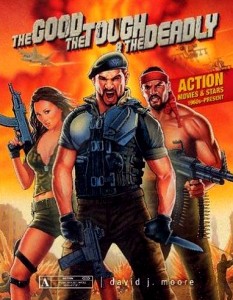
"The Good, the Tough, & the Deadly" Book Cover
Author: David J. Moore
Publisher: Schiffer Publishing
Description: 1 Edition May 25, 2016, Hardcover
Length: 560 pages
By Zach Nix
The Good, the Tough & the Deadly, the latest book from film journalist, David J. Moore, is possibly the most expansive exploration of action and genre cinema to date. Moore’s previous book, World Gone Wild: A Survivor’s Guide to Post-Apocalyptic Movies, was already an impressive feat, as it covered practically every single post-apocalyptic genre film ever made. It even tackled live action and animated television series! However, while World Gone Wild tackled a very niche sub-genre, his latest, The Good, the Tough & the Deadly, covers a much wider array of genre cinema, specifically action films released from 1960 until now. Packed with over one thousand movie reviews, and loads of informative and revealing interviews with the stars and filmmakers responsible for said action films, Moore’s latest is immediately the most encompassing and comprehensive examination, exploration, and celebration of all things action.
Although one may be eager to dive into the book to read about their favorite action movies, it is extremely important to read the introduction, as it breaks down exactly which action movies and stars Moore and his fellow co-writers set out to examine within the book. First off, all of the movies reviewed within the book were chosen based upon which action stars headlined or inhabited said films. Second, the action stars chosen to write about had to come from a background in sports, wrestling, martial arts, bodybuilding, and/or stunt work. Actors who happen to make action films, such as Clint Eastwood, Kurt Russell, or Mel Gibson, were not considered. Moore and his co-writers are only interested in the real deal: actors who are labeled as action stars, who more or less play themselves from film to film, and have dedicated a majority of their career and persona to action cinema. They also chose to exclude the multitude of sword and sorcery and martial arts films that exist, as those sub-genres could suffice their own book and are truly never ending. Speaking of martial artists, only those who made a huge impact on the genre or crossed cultures to have an effect on international audiences were included. After all, Moore and friends had to narrow their criteria down to something. Otherwise, their book could never end.
The plentiful movie reviews make up the bulk of the text. Each review includes which format the film was watched upon (they keep it simple, DVD or VHS only), a paragraph or two on the summary of the film, and than a piece on the writer’s opinion of the film and how it reflects its action star. Some films have very little written about them, as much as two paragraphs, while others have fairly lengthy pieces spanning a couple paragraphs. While it would have been nice to have more in depth reviews for every single one of the films, it makes sense that most of them just get small blurbs, as an in depth review for every film would turn the book into its own encyclopedia series. Therefore, understand that in order for the book to amass over one thousand reviews, it couldn’t provide an in depth essay for every single film. Than again, I don’t think anyone is chomping at the bit to write an essay about Death Wish V: The Face of Death or Cyborg Cop 2. There are simply too many films and too many sequels to cover in an equal fashion.
As far as the specifics of the reviews come, each one is written in a matter that gives you a sense of the film’s plot and overall experience. After tackling the introduction, which I cannot stress enough, I still found myself repeatedly surprised to see which films made the cut, but understood the author’s criteria and reason for their inclusion. For example, Scooby Doo! WrestleMania Mystery, a DTV children’s cartoon, is included because it features John Cena, an action star whose background comes from sports and wrestling. While I fully expected to see English language Jackie Chan ventures like the Rush Hour and Shanghai films pop up, I completely forgot that Chan had co-starred in Disney’s remake of Around the World in 80 Days, and that it even included extensive martial arts sequences. I even forgot that Crocodile Hunter: Collision Course, starring world famous animal expert, Steve Irwin, even existed, let alone classified as an action film. But alas, Moore breaks down how Irwin is essentially a stunt man, regarding his crazy antics with animals, and therefore, qualifies for the book. In regards to films that I know and expected, I was pleasantly surprised to see that the writer shared my sentiments towards Safe, arguably Jason Statham’s greatest all around action movie, an opinion that I had always felt alone on. However, I was a little taken aback by some of the over whelming positive words written about some of Steven Seagal and Jean Claude Van Damme’s lesser DTV films. I never expected to read praise about Seagal’s performance in A Dangerous Man or that Derailed is superior to Seagal’s own Under Siege 2. But alas, that’s where some of the fun comes from in reading this book.
The real treasures of this book, as with World Gone Wild, are the interviews, which offer up a great insider’s look at these stars and their work. The stars interviewed range all over the place, from Carl Weathers, to Michael Dudikoff, to Al Leong, to Cynthia Rothrock, to Zoe Bell, and even Wesley Snipes. Honestly, if you can think of them, they are probably interviewed within the book. Several directors and writers are interviewed as well, including DTV veterans Isaac Florentine and John Hyams. It’s really nice to hear some of these stars and filmmakers discuss both their successes and failures in detail. After all, failures and bombs deserve to be given the time of day as much as the successes.
For example, Martyn Burke, the director of Avenging Angelo, reveals a lot about Stallone’s one and only DTV film, the movie that more or less marked the lowest point of his career. Burke describes how shady the production was, and how $15 million of the film’s budget vanished. He even discusses how he would have to go toe to toe with Stallone every morning of the shoot regarding creative differences. Even though it’s clear that Avenging Angelo was nothing more than a disaster, you can tell that Burke has a great attitude about the whole experience from his interview. Another interview, one with writer Steve Latshaw, reveals that Van Damme’s In Hell was originally to be a forty million dollar theatrical comeback vehicle at Warner Bros, but instead became a Millennium picture for a mere $5 million. An interview with Daniel Bernhardt, the star of Bloodsport II, reveals how truly genuine and humble a person he is, even going so far as to not consider himself an action star. And as a big fan of Scott Adkins, I was over joyed to find not one, but two interviews with him that cover nearly all of his films. All in all, the interviews are the true treasure of the text, and a big incentive to buy this book instead of simply flipping through it at the bookstore.
At the very end of the book, one will find both an index on the book’s stars, as well as an all around index of every single film covered. I especially enjoyed the index of action stars, as it makes it simple to figure out who is and who is not covered within the book, along with which pages one can find their interviews.
In conclusion, The Good, the Tough & the Deadly is mostly a book for people who already love action movies, and are looking for opinions or a historical overview of the films they already love, whilst also discovering new action movies and stars that they have never heard of along the way. If you are new to action films, than you should probably start with a more historical text and watch many of the action classics yourself, because Moore’s epic hardcover isn’t going to give you the “Action 101” you may need. That being said, The Good, the Tough & the Deadly is a celebration amongst action fanatics like myself, as it is more or less the ultimate love letter to all things action and bad ass cinema. As I write this review, I still have not been able to take in every single piece of text within the book, as it is that overwhelming and comprehensive. I cannot recommend a purchase enough, as the book will last any action fanatic weeks from cover to cover. From now on, when action movie lovers go on to Amazon and type in “action movies book,” Moore’s bible to all things action and the action star will always be the one that pops up, and rightfully so.
I would like to thank David J. Moore and Schiffer Publishing for providing me with a copy of the book to review. It will forever stand as one of my prized possessions within my book collection.
Zach Nix’s Rating: 9/10

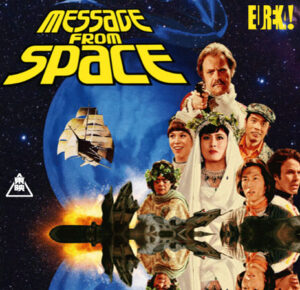
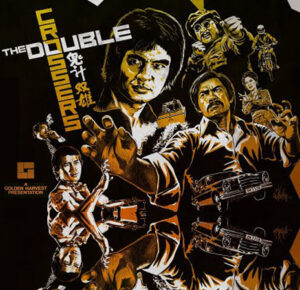
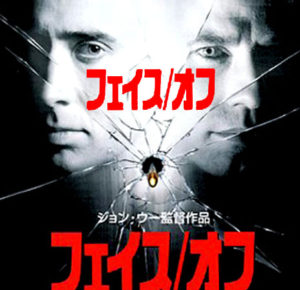

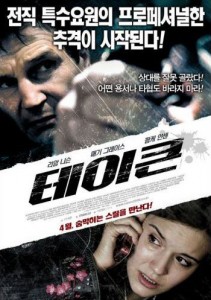





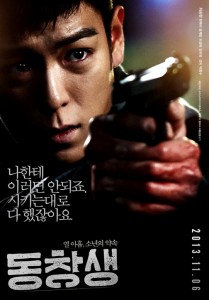
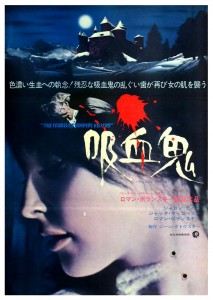

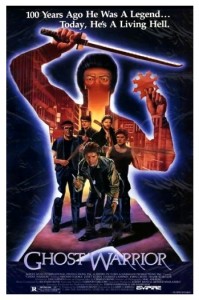

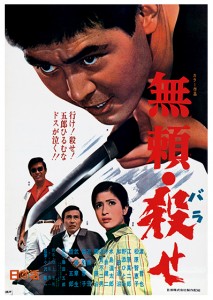
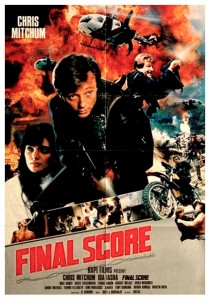
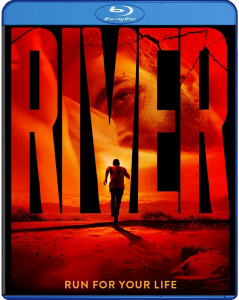



Be the 1st to Comment